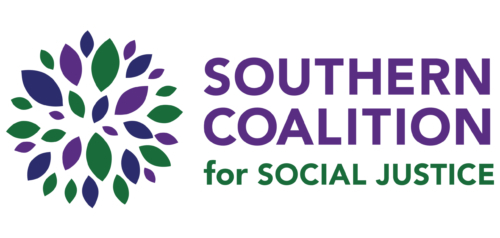In an interview aired today on Charlotte’s WFAE News, SCSJ Executive Director Anita Earls discussed the history and current state of North Carolina’s protracted redistricting battle as well as what the long-awaited N.C. Supreme Court ruling on the matter will mean for the state’s electoral future. The transcript of the full story is posted below.
Three Years Later, NC Redistricting Still in Court
by Michael Tomsic
This week, the U.S. Supreme Court will hear an Alabama redistricting case that could impact legislative maps in North Carolina. In fact, the Alabama case may be part of the reason the North Carolina Supreme Court still hasn’t ruled on the redistricting plan here even though it heard the case almost a year ago.
In the meantime, North Carolina held another election using some districts that civil rights activists say unfairly target African-American voters.
State lawmakers redraw North Carolina’s Congressional and legislative districts after the Census every 10 years. In 2011, Republicans gained control of the General Assembly, so they drew the maps.
Attorneys representing the North Carolina NAACP say the result was racial gerrymandering: Republicans moved African-Americans out of demographically mixed districts and packed them into a few mostly black districts.
“And so going block by block to divide them back on the basis of race is really not only sort of offensive to them on a personal level, but it’s also weakening their influence,” said attorney Anita Earls.
It’s certainly making it harder for Democrats to get elected because some of their most loyal voters have been carved out of what were competitive districts.
Think about the packing argument this way: would you rather be able to consistently elect one candidate in one district, or swing the election of several candidates in several districts?
The argument has been playing out for several years. The U.S. Justice Department pre-cleared the maps. Last year, a three-judge panel upheld them. And then the state Supreme Court heard arguments in January.
Ever since, “nothing,” said Earls. “We are at the mercy of the state Supreme Court, which has just failed to issue a ruling.”
This is one area where Anita Earls and the lawmakers who drew the maps agree:
“We believe that it’s time for the legal battles to end and allow this to move forward,” said Republican state Senator Bob Rucho of Matthews.
He says he and his colleagues were following Voting Rights Act requirements when they created more majority-minority districts.
Former North Carolina Supreme Court Justice Bob Orr says it is unusual for this much time to pass without a decision.
“This one has taken longer than I think anybody expected,” he said.
But Orr said there’s no rule requiring a decision within a certain amount of time, and this kind of delay is not unprecedented.
In fact, there have been 14 other North Carolina Supreme Court cases in the past three years where the gap between oral arguments and a decision was at least 10 months, according to records provided by the clerk of court.
Orr says sometimes it just takes the justices a while to reach a consensus and write the opinion. Also, elections can get in the way.
“The pressures of conducting a statewide campaign pull you away from your day-to-day activities at the court,” Orr said.
Four sitting justices just went through that process. Two won reelection, one lost, and the race for the fourth was so close there may be a recount.
Depending on that, there’ll be one or two new justices. Orr said new justices usually don’t participate in old cases, so there’ll probably be a smaller pool deciding the redistricting case.
Orr said another part of the holdup could be the U.S. Supreme Court’s decision to hear a similar case involving Alabama redistricting.
“The North Carolina court could say, well OK, we’re going to wait and see what the U.S. Supreme Court says and we won’t issue anything until then,” he said.
That case also involves allegations of Republican lawmakers packing African-Americans into a few districts, and attorneys in the North Carolina case filed a friend-of-the-court brief.
The nation’s highest court will hear arguments Wednesday, but it might not rule until this summer.
In North Carolina, attorney Anita Earls says if the maps are overturned, “it will mean that we’ve already had two election cycles using unconstitutional maps, and there’ll be a scramble to get something new in place for 2016.”
After the 2020 Census, North Carolina goes through the whole process again.
